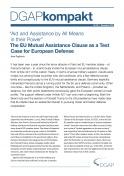*
The security situation in and around Europe has hardly improved since November 17, 2015, when French Defense Minister Jean-Yves Le Drian stood before his fellow EU defense ministers and formally requested military assistance from all EU member states. The threat of domestic terrorism has continued to grow, states in the Middle East and Africa continue to fail, and Russia continues to contribute to instability in the post-Soviet sphere. Now Europe is bracing for the inauguration of US President-elect Donald Trump, whose campaign loudly called Washington’s security guarantee for Europe into question. European security policy requires greater unity, greater resources, and more robust mechanisms for facing the uncertain future.
Against this background, it is worth looking carefully at what has been achieved in the past 12 months. When France activated Article 42.7 of the Lisbon Treaty (Treaty of the European Union, or TEU), it was the first EU member state to invoke Europe’s “mutual assistance clause” since the treaty went into effect in 2009. France, as a victim of “armed aggression on its own territory” was requesting “aid and assistance by all means in their power” from other member states. In fact, the decision took other EU states entirely by surprise. Immediately after the November 13, 2015 attacks in Paris, there was speculation that NATO’s Article 5 would be invoked, but no one had considered Article 42.7 of the TEU. Given the lack of precedence, the concrete application of the mutual assistance clause was at first unclear.
France’s decision inevitably raised questions about what mutual assistance actually means in a European context: How did member states interpret Article 42.7? What would the consequences be for their own behavior? Which concrete actions followed from it? And which functions did it accord to the European institutions?
Read the rest of the article by clicking on the box to the right.

